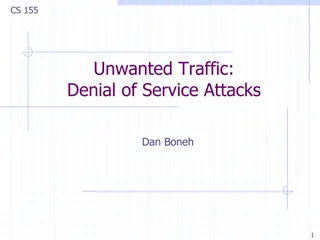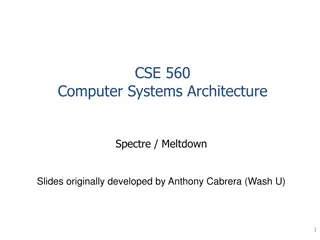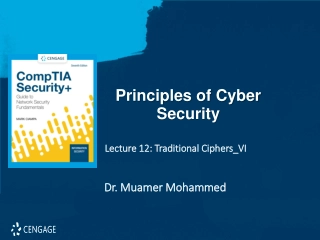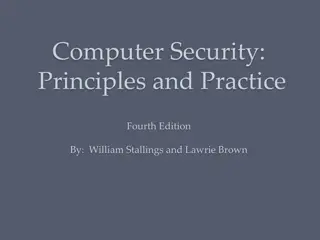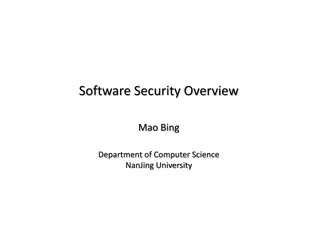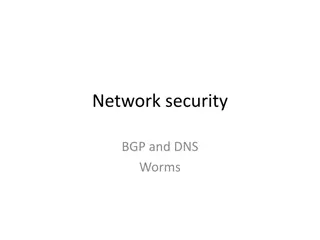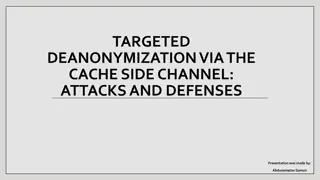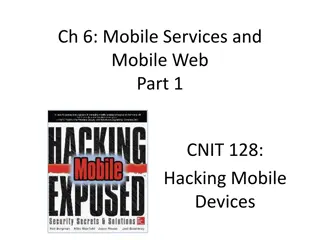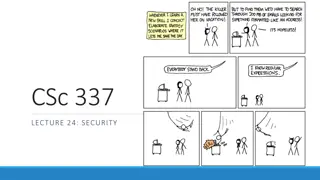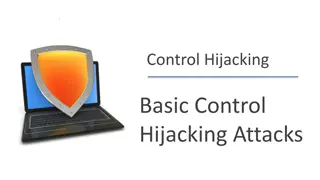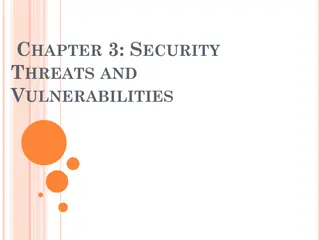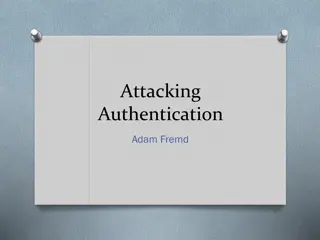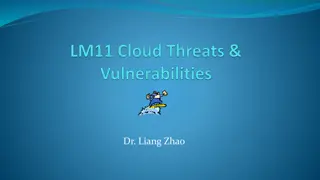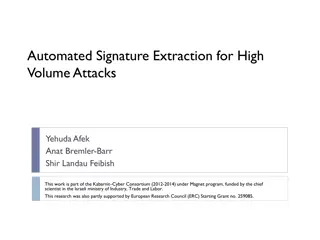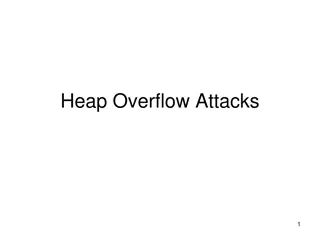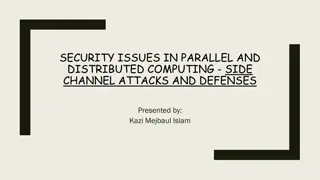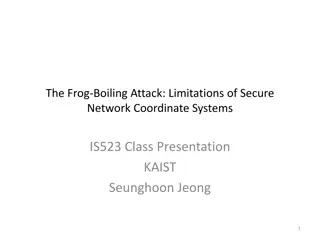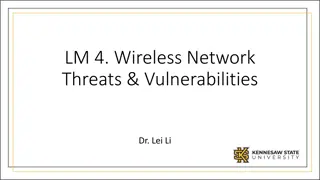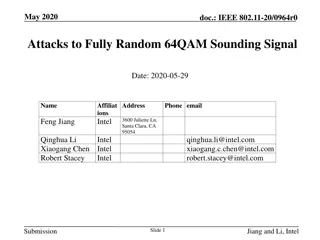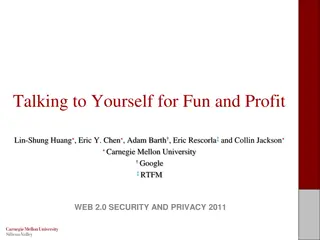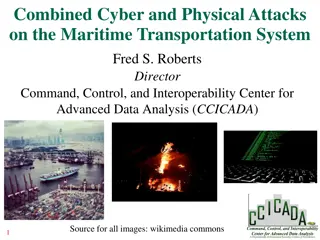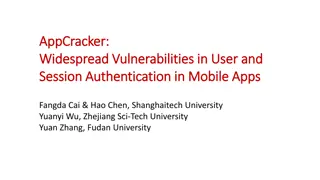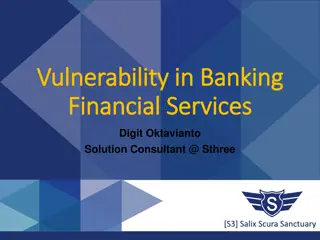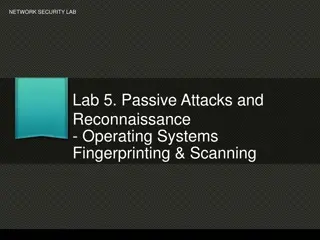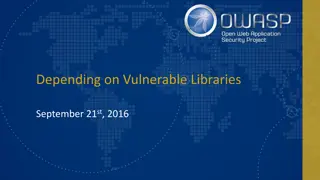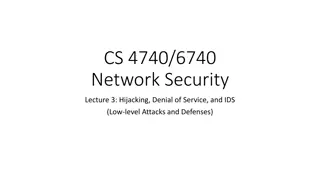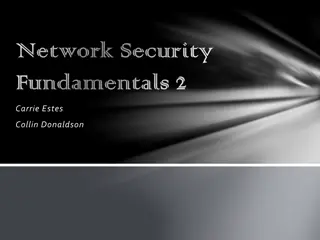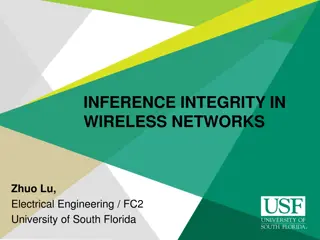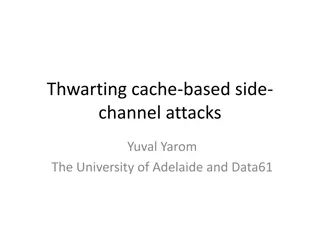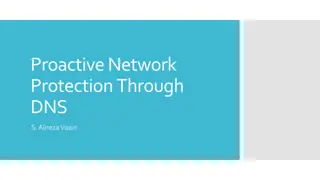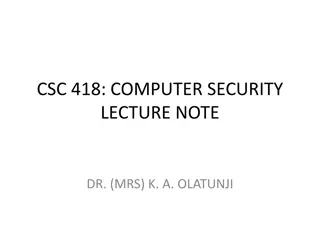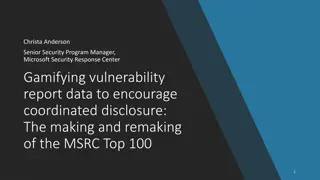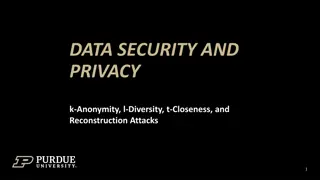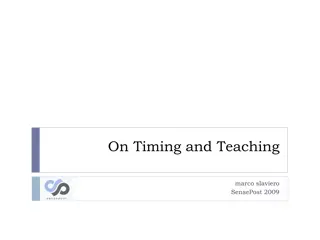Understanding Network Security Vulnerabilities and Attacks
Explore the world of network security vulnerabilities and attacks, including Denial-of-Service (DoS) and Distributed-Denial-of-Service (D-DoS), security flaws in the TCP/IP protocol suite, ICMP attacks, routing attacks, and TCP attacks. Learn about common security vulnerabilities such as address spoofing, IP fragmentation attacks, and ping floods, as well as the risks associated with insecure IP configurations. Discover the importance of implementing security measures like firewalls and intrusion detection systems to protect against malicious attacks on different layers of the network.
Download Presentation

Please find below an Image/Link to download the presentation.
The content on the website is provided AS IS for your information and personal use only. It may not be sold, licensed, or shared on other websites without obtaining consent from the author. Download presentation by click this link. If you encounter any issues during the download, it is possible that the publisher has removed the file from their server.
E N D
Presentation Transcript
Network security vulnerabilities By Anonymous Student
Outline Security vulnerabilities Denial-of-Service (DoS) and Distributed-Denial-of- Service (D-DoS) Firewalls Intrusion Detection Systems (IDS)
Security vulnerabilities Security problems in the TCP/IP protocol suite Attacks on different layers: IP Attacks ICMP Attacks Routing Attacks TCP Attacks Application Layer Attacks
Security flaws in IP The IP addresses are filled in by the originating host Address spoofing Using source address for authentication Can A claim it is B to the server S? 2.1.1.1 C ARP Spoofing Can C claim it is B to the server S? Internet 1.1.1.3 S Source Routing 1.1.1.1 1.1.1.2 A B
Security flaws in IP IP fragmentation attack End hosts need to keep the fragments till all the fragments arrive Traffic amplification attack IP allows broadcast destination
Ping Flood Internet Attacking System Broadcast Enabled Network Victim System Image Courtesy: [1]
ICMP attacks No authentication ICMP redirect message Can cause the host to switch gateways Benefit of doing this? Man in the middle attack, sniffing ICMP destination unreachable Can cause the host to drop connection ICMP echo request/reply
Routing attacks Distance Vector Routing (DVR) Announce ZERO distance to all other nodes Blackhole traffic Eavesdrop Link State Routing (LSR) Can drop links randomly Can claim direct link to any other routers A bit harder to attack than DV Border Gateway Protocol (BGP) Autonomous Systems (ASes) can announce arbitrary prefix ASes can alter path
TCP attacks Image Courtesy: [1] SYN x SYN y | ACK x+1 ACK y+1 Client Server Issues Server needs to keep waiting for ACK y+1 Server recognizes Client based on IP address/port and y+1
TCP Layer attacks TCP SYN Flooding Exploit state allocated at server after initial SYN packet Send a SYN and don t reply with ACK Server will wait for 511 seconds for ACK Finite queue size for incomplete connections (1024) Once the queue is full it doesn t accept requests
TCP Layer attacks TCP Session Hijack When is a TCP packet valid? Address/Port/Sequence Number in window How to get sequence number? Sniff traffic Guess it Many earlier systems had predictable ISN Inject arbitrary data to the connection
TCP Layer attacks TCP Session Poisoning Send Reset (RST) packet Will tear down connection Do you have to guess the exact sequence number? Anywhere in window is fine For 64k window it takes 64k packets to reset About 15 seconds for a T1
Application Layer attacks Applications don t authenticate properly Authentication information in clear FTP, Telnet, POP Domain Name System (DNS) insecurity DNS poisoning DNS zone transfer
Outline Security vulnerabilities DoS and D-DoS Firewalls Intrusion Detection Systems (IDS) You are here
Denial-of-Service (DoS) Objective make a service unusable, usually by overloading the server or network Consume host resources TCP SYN floods ICMP ECHO (ping) floods Consume bandwidth UDP floods ICMP floods
Denial-of-Service (DoS) Crashing the victim Ping-of-Death TCP options (unused, or used incorrectly) Forcing more computation Taking long path in processing of packets
Simple DoS The Attacker usually spoofed source address to hide origin Easy to block Attacker Victim Victim Victim Image Courtesy: [1]
Co-ordinated DoS Image Courtesy: [1] Attacker Attacker Attacker Victim Victim Victim The first attacker attacks a different victim to cover up the real attack The Attacker usually spoofed source address to hide origin Harder to deal with
Distributed DoS Attacker Handler Handler Agent Agent Agent Agent Agent Victim Image Courtesy: [1]
Distributed DoS The handlers are usually very high volume servers Easy to hide the attack packets The agents are usually home users with DSL/Cable Already infected and the agent installed Very difficult to track down the attacker How to differentiate between DDoS and Flash Crowd? Flash Crowd Many clients using a service legimitaly
Outline Security Vulnerabilities DoS and D-DoS Firewalls Intrusion Detection Systems (IDS) You are here
Firewalls Lots of vulnerabilities on hosts in network Users don t keep systems up to date Lots of patches Lots of exploits in wild (no patch for them) Solution Limit access to the network Put firewalls across the perimeter of the network
Firewalls Firewall inspects traffic through it Allows traffic specified in the policy Drops everything else Two Types Packet Filters, Proxies Firewall Internal Network Internet Image Courtesy: [1]
Packet Filters Packet filter selectively passes packets from one network interface to another Usually done within a router between external and internal networks Screening router Can be done by a dedicated network element Packet filtering bridge Harder to detect and attack than screening routers
Typical Firewall Configuration Internet Internal hosts can access DMZ and Internet External hosts can access DMZ only, not Intranet DMZ DMZ hosts can access Internet only X X Advantages: If a service gets compromised in DMZ it cannot affect internal hosts Intranet Image Courtesy: [1]
Packet Filters Advantages Transparent to application/user Simple packet filters can be efficient Disadvantages Very hard to configure the rules Doesn t have enough information to take actions Does port 22 always mean SSH? Who is the user accessing the SSH?
Proxy Firewall Data Available Application level information User information Advantages Better policy enforcement Better logging Disadvantages Doesn t perform as well One proxy for each application Client modification
Outline Security Vulnerabilities DoS and DDoS Firewalls Intrusion Detection Systems (IDS) You are here
Intrusion Detection Systems Firewalls allow traffic only to legitimate hosts and services Traffic to the legitimate hosts/services can have attacks CodeReds on IIS Solution Intrusion Detection Systems Monitor data and behavior Report when identify attacks
Types of IDS Signature-based (SIDS) Anomaly-based (AIDS) Host-based (HIDS) Network-based (NIDS)
Signature-based IDS (SIDS) Characteristics Uses known pattern matching to signify attack Advantages Widely available Fairly fast Easy to implement Easy to update Disadvantages Cannot detect attacks for which it has no signature
Anomaly-based IDS (AIDS) Characteristics Uses statistical model or machine learning engine Recognizes deviations from normal as potential intrusions Advantages Can detect attempts to exploit new and unforeseen vulnerabilities Can recognize authorized usage that falls outside the normal pattern Disadvantages Generally slower, more resource intensive compared to signature-based IDS Greater complexity, difficult to configure Higher percentages of false alerts
Network-based IDS (NIDS) Characteristics NIDS examine raw packets in the network passively and triggers alerts Advantages Easy deployment Unobtrusive Difficult to evade if done at low level of network operation Disadvantages Different hosts process packets differently NIDS needs to create traffic seen at the end host Need to have the complete network topology and complete host behavior
Host-based IDS (HIDS) Characteristics Runs on single host Can analyze audit-trails, logs, integrity of files and directories, etc. Advantages More accurate than NIDS Less volume of traffic so less overhead Disadvantages Deployment is expensive What happens when host get compromised?
Summary TCP/IP security vulnerabilities Spoofing Flooding attacks TCP session poisoning DoS and D-DoS Firewalls Packet Filters Proxy IDS Signature and Anomaly IDS NIDS and HIDS
References [1] Srinivasan Seshan, Network Security Attacks & Defenses , Carnegie Mellon University, Pittsburgh, PA, 2005. [2] V. A. Vallivaara, M. Sailio, and K. Halunen, "Detecting man-in-the-middle attacks on non-mobile systems," presented at the Proceedings of the 4th ACM conference on Data and application security and privacy, San Antonio, Texas, USA, 2014. [3] C. Xiuzhen, L. Shenghong, M. Jin, and L. Jianhua, "Quantitative threat assessment of denial of service attacks on service availability," in Computer Science and Automation Engineering (CSAE), 2011 IEEE International Conference on, 2011, pp. 220-224. [4] B. J. Neubauer and J. D. Harris, "Protection of computer systems from computer viruses: ethical and practical issues," J. Comput. Sci. Coll., vol. 18, pp. 270-279, 2002. [5] L. Liu, X. Zhang, G. Yan, and S. Chen, "Exploitation and threat analysis of open mobile devices," presented at the Proceedings of the 5th ACM/IEEE Symposium on Architectures for Networking and Communications Systems, Princeton, New Jersey, 2009. [6] SCADA Library, Article/Whitepaper, Chapter 1 - Network Security - Vulnerabilities, Threats and Attacks , http://scadahacker.com/library/Documents/Course_Manual/handouts/Network%20S ecurity%20-%20Chap%201%20-%20Vulns-Threats-Attacks.pdf




